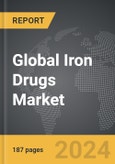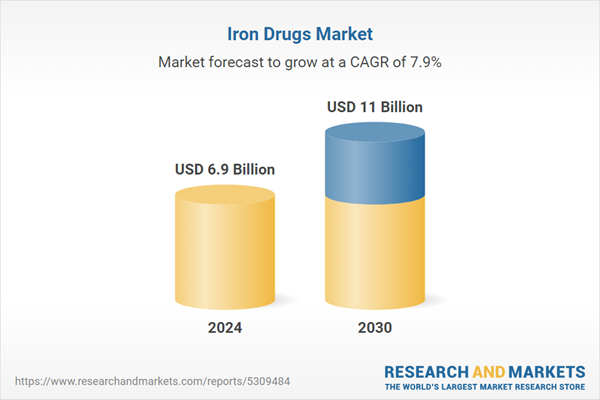The global market for Iron Drugs was valued at US$6.9 Billion in 2024 and is projected to reach US$11.0 Billion by 2030, growing at a CAGR of 7.9% from 2024 to 2030. This comprehensive report provides an in-depth analysis of market trends, drivers, and forecasts, helping you make informed business decisions. The report includes the most recent global tariff developments and how they impact the Iron Drugs market.
Segments: Product (Oral Drugs, IV Drugs).
Geographic Regions/Countries: World; United States; Canada; Japan; China; Europe (France; Germany; Italy; United Kingdom; Spain; Russia; and Rest of Europe); Asia-Pacific (Australia; India; South Korea; and Rest of Asia-Pacific); Latin America (Argentina; Brazil; Mexico; and Rest of Latin America); Middle East (Iran; Israel; Saudi Arabia; United Arab Emirates; and Rest of Middle East); and Africa.
The analysts continuously track trade developments worldwide, drawing insights from leading global economists and over 200 industry and policy institutions, including think tanks, trade organizations, and national economic advisory bodies. This intelligence is integrated into forecasting models to provide timely, data-driven analysis of emerging risks and opportunities.
Global Iron Drugs Market - Key Trends & Strategic Insights
Why Are Iron Drugs Essential in Treating Iron Deficiency Disorders?
Iron drugs play a critical role in the treatment of iron deficiency disorders, including iron deficiency anemia (IDA) and other conditions where iron supplementation is necessary. These drugs are used to replenish the body's iron stores, enabling the production of hemoglobin and the proper functioning of red blood cells. Iron deficiency can result from various causes, such as inadequate dietary intake, chronic blood loss, or malabsorption syndromes, making iron drugs a key component of treatment protocols across different patient populations. The effectiveness of iron drugs in improving hemoglobin levels and alleviating symptoms such as fatigue and weakness underscores their importance in clinical practice.How Are New Formulations Enhancing the Efficacy of Iron Drugs?
Recent advancements in iron drug formulations are enhancing their efficacy and tolerability, addressing some of the limitations of traditional iron supplements. For example, the development of polysaccharide-iron complex and heme iron polypeptide formulations has improved the absorption of iron in the gastrointestinal tract, reducing the gastrointestinal side effects that are common with older iron salts like ferrous sulfate. Additionally, the introduction of intravenous (IV) iron preparations, such as ferric carboxymaltose and iron sucrose, offers a faster and more efficient means of replenishing iron stores, particularly in patients with severe anemia or those who cannot tolerate oral iron. These new formulations are expanding the range of treatment options available to healthcare providers, allowing for more personalized and effective management of iron deficiency.What Challenges Are Associated with Iron Drug Therapy, and How Are They Being Addressed?
Iron drug therapy, while effective, is not without challenges. One of the most common issues is the gastrointestinal discomfort associated with oral iron supplements, which can lead to poor patient adherence. To address this, newer formulations with better tolerability are being developed, and patients are being educated on how to minimize side effects, such as by taking supplements with food. Another challenge is the risk of iron overload, particularly in patients receiving long-term therapy or those with conditions like hemochromatosis. Careful monitoring of iron levels and individualized dosing strategies are essential to mitigate this risk. Additionally, the cost and availability of newer IV iron formulations can be a barrier for some patients, particularly in low-resource settings. Efforts to increase access to affordable iron therapies and educate healthcare providers on best practices are crucial to overcoming these challenges.Which Factors Are Propelling the Growth of the Iron Drugs Market?
The growth of the iron drugs market is driven by several factors, including the increasing prevalence of iron deficiency and related disorders, the development of new and improved formulations, and the expansion of healthcare infrastructure in emerging markets. As the global burden of anemia continues to rise, particularly among women, children, and the elderly, the demand for effective iron therapies is growing. The introduction of advanced formulations that offer better absorption, fewer side effects, and faster results is also driving market growth by providing more effective treatment options. Additionally, the growing awareness of the importance of early diagnosis and treatment of iron deficiency, coupled with the expansion of healthcare services in developing regions, is increasing the uptake of iron drugs. As more healthcare providers adopt these newer therapies and as patients become more informed about their options, the iron drugs market is expected to continue its upward trajectory.Report Scope
The report analyzes the Iron Drugs market, presented in terms of units. The analysis covers the key segments and geographic regions outlined below.Segments: Product (Oral Drugs, IV Drugs).
Geographic Regions/Countries: World; United States; Canada; Japan; China; Europe (France; Germany; Italy; United Kingdom; Spain; Russia; and Rest of Europe); Asia-Pacific (Australia; India; South Korea; and Rest of Asia-Pacific); Latin America (Argentina; Brazil; Mexico; and Rest of Latin America); Middle East (Iran; Israel; Saudi Arabia; United Arab Emirates; and Rest of Middle East); and Africa.
Key Insights:
- Market Growth: Understand the significant growth trajectory of the Oral Drugs segment, which is expected to reach US$6.7 Billion by 2030 with a CAGR of a 9.2%. The IV Drugs segment is also set to grow at 6.1% CAGR over the analysis period.
- Regional Analysis: Gain insights into the U.S. market, valued at $1.8 Billion in 2024, and China, forecasted to grow at an impressive 11.9% CAGR to reach $2.8 Billion by 2030. Discover growth trends in other key regions, including Japan, Canada, Germany, and the Asia-Pacific.
Why You Should Buy This Report:
- Detailed Market Analysis: Access a thorough analysis of the Global Iron Drugs Market, covering all major geographic regions and market segments.
- Competitive Insights: Get an overview of the competitive landscape, including the market presence of major players across different geographies.
- Future Trends and Drivers: Understand the key trends and drivers shaping the future of the Global Iron Drugs Market.
- Actionable Insights: Benefit from actionable insights that can help you identify new revenue opportunities and make strategic business decisions.
Key Questions Answered:
- How is the Global Iron Drugs Market expected to evolve by 2030?
- What are the main drivers and restraints affecting the market?
- Which market segments will grow the most over the forecast period?
- How will market shares for different regions and segments change by 2030?
- Who are the leading players in the market, and what are their prospects?
Report Features:
- Comprehensive Market Data: Independent analysis of annual sales and market forecasts in US$ Million from 2024 to 2030.
- In-Depth Regional Analysis: Detailed insights into key markets, including the U.S., China, Japan, Canada, Europe, Asia-Pacific, Latin America, Middle East, and Africa.
- Company Profiles: Coverage of players such as Allergan, Inc., AMAG Pharmaceuticals, Inc., American Regent, Inc., Daiichi Sankyo Company, Ltd., Fresenius Medical Care AG & Co. and more.
- Complimentary Updates: Receive free report updates for one year to keep you informed of the latest market developments.
Some of the 28 companies featured in this Iron Drugs market report include:
- Allergan, Inc.
- AMAG Pharmaceuticals, Inc.
- American Regent, Inc.
- Daiichi Sankyo Company, Ltd.
- Fresenius Medical Care AG & Co.
- Nippon Shinyaku Co., Ltd
- Pharmacosmos A/S
- Rockwell Medical Technologies, Inc.
- Sanofi
- Shield Therapeutics Plc
- Vifor Pharma Management Ltd.
Tariff Impact Analysis: Key Insights for 2025
Global tariff negotiations across 180+ countries are reshaping supply chains, costs, and competitiveness. This report reflects the latest developments as of April 2025 and incorporates forward-looking insights into the market outlook.The analysts continuously track trade developments worldwide, drawing insights from leading global economists and over 200 industry and policy institutions, including think tanks, trade organizations, and national economic advisory bodies. This intelligence is integrated into forecasting models to provide timely, data-driven analysis of emerging risks and opportunities.
What’s Included in This Edition:
- Tariff-adjusted market forecasts by region and segment
- Analysis of cost and supply chain implications by sourcing and trade exposure
- Strategic insights into geographic shifts
Buyers receive a free July 2025 update with:
- Finalized tariff impacts and new trade agreement effects
- Updated projections reflecting global sourcing and cost shifts
- Expanded country-specific coverage across the industry
Table of Contents
I. METHODOLOGYII. EXECUTIVE SUMMARY2. FOCUS ON SELECT PLAYERSIII. MARKET ANALYSISIV. COMPETITION
1. MARKET OVERVIEW
3. MARKET TRENDS & DRIVERS
4. GLOBAL MARKET PERSPECTIVE
UNITED STATES
CANADA
JAPAN
CHINA
EUROPE
FRANCE
GERMANY
ITALY
UNITED KINGDOM
SPAIN
RUSSIA
REST OF EUROPE
ASIA-PACIFIC
AUSTRALIA
INDIA
SOUTH KOREA
REST OF ASIA-PACIFIC
LATIN AMERICA
ARGENTINA
BRAZIL
MEXICO
REST OF LATIN AMERICA
MIDDLE EAST
IRAN
ISRAEL
SAUDI ARABIA
UNITED ARAB EMIRATES
REST OF MIDDLE EAST
AFRICA
Companies Mentioned (Partial List)
A selection of companies mentioned in this report includes, but is not limited to:
- Allergan, Inc.
- AMAG Pharmaceuticals, Inc.
- American Regent, Inc.
- Daiichi Sankyo Company, Ltd.
- Fresenius Medical Care AG & Co.
- Nippon Shinyaku Co., Ltd
- Pharmacosmos A/S
- Rockwell Medical Technologies, Inc.
- Sanofi
- Shield Therapeutics Plc
- Vifor Pharma Management Ltd.
Table Information
| Report Attribute | Details |
|---|---|
| No. of Pages | 187 |
| Published | April 2025 |
| Forecast Period | 2024 - 2030 |
| Estimated Market Value ( USD | $ 6.9 Billion |
| Forecasted Market Value ( USD | $ 11 Billion |
| Compound Annual Growth Rate | 7.9% |
| Regions Covered | Global |









